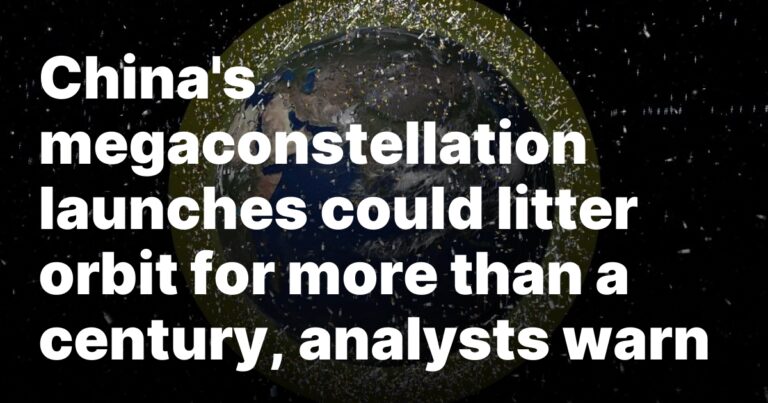HELSINKI — China’s construction of a pair of communications megaconstellations could cloud low Earth orbit with large spent rocket stages for decades or beyond, according to analysts.
Launches for the government’s Guowang and Shanghai-backed but more commercially oriented Qianfan (Thousand Sails) constellation began in the second half 2024, with each planned to consist of over 10,000 satellites, demanding more than a thousand launches in the coming years.
But despite emerging global norms and growing concern about orbital sustainability, China is leaving the upper stages of the rockets used for the launches in orbits that will persist in low Earth orbit (LEO) for over a century.
“There will be some 1,000+ PRC [People’s Republic of China] launches over the next several years deploying these constellations,” Jim Shell, a space domain awareness and orbital debris expert at Novarum Tech, said in his analysis shared on social media platform X. “I have not yet completed the calculations but the orbital debris mass in LEO will be dominated by PRC upper stages in short order unless something changes (sigh).”
“For both constellations, the rocket upper stages are being left in high altitude orbits — generally with orbital lifetimes greater than 100 years.”
Shell illustrated his point with a graphic showing upper stages from Long March 6A and 8 series rockets in orbits between 720 and 780 kilometers using data from U.S. Space Force space domain awareness—well above the threshold of around 600 km typically aligned with global best practices for post-mission disposal, such as a 25 year orbital lifetime.
At these higher altitudes, the lack of atmospheric density means these large pieces of debris could remain in orbit—as a threat for collisions and creating further debris—for more than a hundred years. This could threaten the sustainable use of LEO.
“Incredibly irresponsible”
Victoria Samson, Chief Director, Space Security and Stability at the Secure World Foundation, echoed these concerns.
“Generally speaking, this is not good for anyone who wants to continue to receive benefits from the use of space. Pieces of debris at that altitude will stick around for years, if not decades,” Samson told SpaceNews.
“Leaving those rocket bodies at 700-800 km altitude is incredibly irresponsible. China is just beginning to launch its very large constellations so there is time to fix this before it becomes a grave danger.”
Samson added that China should work on active debris removal (ADR) missions to clean up earlier debris that it created, adding that this applied for both the United States and Russia also.
Jonathan McDowell, an astronomer at the Harvard-Smithsonian Center for Astrophysics who also tracks spaceflight activities, told SpaceNews that he agrees with the concerns expressed by Shell. McDowell notes, however, that the Long March 5B rocket used for the first Guowang launch in December 2024 was a much better approach in terms of debris.
The Long March 5B—notably which caused alarm when its first stages went orbital and made uncontrolled reentries when launching modules for the Tiangong space station—used a Yuanzheng-2 upper stage. This is able to perform multiple burns in order to insert satellites into intended orbits and then deorbit itself. The use of the YZ-2 also means the Long March 5B first stage remains suborbital.
“If they carry on with CZ-6A and CZ-8, then it’s very bad for the upper LEO debris environment,” says McDowell.
China is also close to debuting a range of reusable medium-lift launch vehicles which are expected to compete for contracts to launch Guowang and Qianfan satellites. It will, however, take time to establish these rockets and achieve a high cadence of launches, and how they handle upper stages is yet to be seen.
For now, China has said it is looking to ramp up production of both the Long March 5B and Long March 8.
Shell told SpaceNews that any kind of deorbit burn to lower the perigee of upper stages for the Long March 6A and Long March 8 launches would be helpful. This would increase the atmospheric drag experienced by the stages and lead to shorter deorbiting times. Shell also noted that China is developing its own policies on space debris, as outlined at the UN Committee on Peaceful Uses of Outer Space in February.
“I would recommend other countries use fora such as the UN Committee on Peaceful Uses of Outer Space, which has long-term sustainability on its agenda, to bring up this problem and point-blank ask China how they intend to fix it,” Samson said.
High altitude issues
Megaconstellation launches and the increasing congestion in LEO are concerns in general, with the number of satellites in orbit growing rapidly, along with the numbers of near misses and need for collision-avoidance maneuvers.
The Guowang and Qianfan constellations operate at much higher altitudes than Starlink. Guowang has batches of satellites orbiting at around 1,160 and 915 km, while most Qianfan satellites orbit at just above 1,000 km. Most Starlink satellites orbit at around 550 km.
This means both the satellites from the Chinese megaconstellations and the rockets used to get them into orbit will remain there for much longer if there is no deorbiting burn. Falcon 9 rockets currently used for Starlink launches involve a controlled deorbiting of the upper stage, while some Starlink satellites are deorbited after their mission lifetime. How Guowang and Qianfan satellites are handled after their own lifetimes is another matter of concern.
Shell and others note that China is far from the only contributor to orbital debris. However, the scale and projected persistence of the debris from Guowang and Qianfan launches make the current situation especially alarming. Without changes, a growing cloud of long-lived upper-stage debris could threaten not only Chinese space assets—but the safety and sustainability of all activity in LEO for generations to come.

